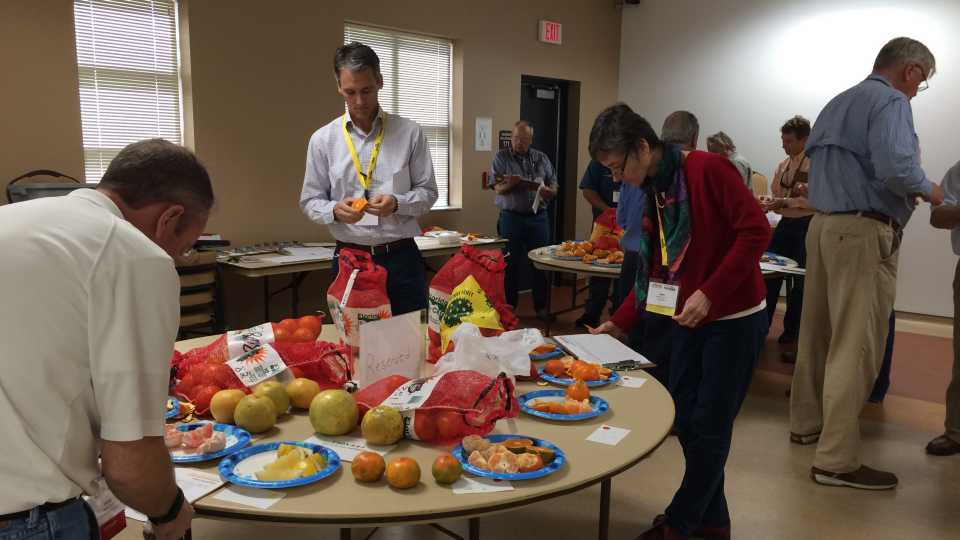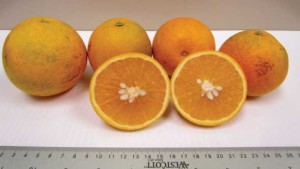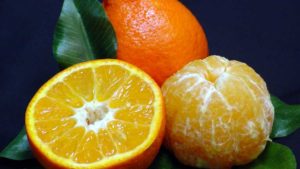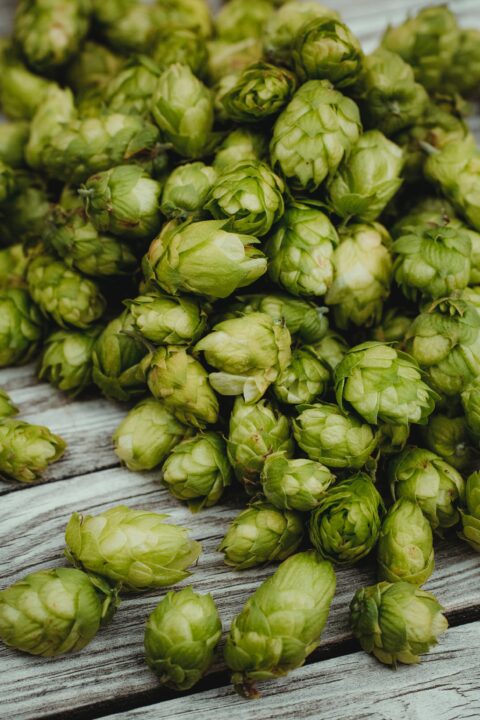Pressure Is on to Pick and Plant Citrus Winners

Feedback from citrus variety surveys help determine which selections are worth vetting further.
Photo by Paul Rusnak
Of all the stones being thrown at HLB, the development of tolerant or resistant rootstocks and scions is among the rocks that could deliver a long-term solution to the disease. The disease itself has flipped the citrus breeding game as researchers widen the search for variety winners.
Peter Chaires, Executive Director of the New Varieties Development & Management Corp. (NVDMC), says a look at pre-HLB days compared to today provides historical context.
“On the processed side of the ledger, there had been very little interest in new oranges before HLB,” Chaires says. “Breeders were working on them to some degree, but most growers were perfectly happy with Hamlin, Mid-Sweet, Pineapple, and Valencia. Since HLB, the breeding programs have really put their foot on the gas to not only get the most promising processing-oriented scions released, but to continue to fill the pipeline with more material — all of which has superior traits. Field screenings for robust or enhanced performance in the face of HLB is a necessary part of this program.
“During this time, the two UF/IFAS OLLs, plus ‘Valquarius’ and the ‘Vernia’ have been made available. More orange hybrids that show enhanced tolerance — and orange-like characteristics but that are not 100% sweet orange — are making their way into trial plantings. Breeding oranges is not like breeding mandarins. It’s a much slower process with fewer development options.
“On the fresh side, the number of developed and released selections has increased drastically. Whereas there used to be one release every 20 years or so, we have seen approximately 22 fresh selections made available through the accelerated programs and a number of private or proprietary selections come into Florida for trial.”
The Challenge
With so much material in the pipeline, it poses a challenge in the development and release process. There was a need to slow down development to learn more about the viability of what is already available.
“In recent years, fewer crosses were made and a greater emphasis has been placed on evaluation,” Chaires says. “Some evaluations are more formal designed experiments, including the collection of hard data, while others are observational.
“What we do know is that breeding cannot be turned on and off like a light switch. As new parents demonstrate promise and new techniques are developed, we must continue to feed the pipeline — though not at the pace we did a few years prior. Growers and nurseries need varieties with superior traits and with the ability to withstand HLB, preferably with minimal care.”
Jude Grosser, a Professor of plant cell genetics for UF/IFAS, who is seeking the best rootstock/scion combinations, says it is complicated because many of the rootstocks in established trials were developed to solve other problems before HLB came along.
“We need to balance this with looking for the ‘home run’ rootstock — which should come from new selections being screened right off the bat for ability to provide protection against HLB in a grafted scion,” Grosser says. “I believe we are looking for a needle(s) in a haystack. So, the bigger the haystack, the better the odds of finding something that will work.”
Grosser has tested thousands of rootstocks hybrids using his “gauntlet” approach. After screening for initial soil adaptation and Phytopthora viability, the more robust candidates are grafted with HLB-infected Valencia and grown off. This is a quick way to see if the rootstock can mitigate the disease.
“I have been doing this for six years, and I have a few hybrid rootstocks that look especially promising,” Grosser says. “Two of which we are producing seed adequate for large scale testing.”
Grosser adds another complicating factor is understanding how these new selections will react to various nutrition programs. Because not all trials have the same program, it can make it harder to make comparisons among trials at different locations.

Due to its attractive features, ‘Bingo’ has grabbed the attention of growers. The fruit appeals to consumer wants and needs.
Photo by Peter Chaires
Promising Contenders
Growers that are replanting are putting new varieties to the test in the real world. Grower Larry Black with Peace River Packing Co. says both resets and new blocks are going in on their farm. He says prior to HLB, he was comfortable with proven industry standards and reluctant to take risks on new materials. But, since HLB, that has changed.
“Our team visits trials to learn more about new selections, and we interact with the plant breeders and other growers,” Black says. “Peace River Valley Citrus Growers Association hosts several rootstock and scion trials with the breeding programs from UF/IFAS and USDA. We also participate in the NVDMC FAST TRACK program to trial promising new material in our growing conditions.”

Florida EV2
Photo courtesy of UF/IFAs
Black says for its fresh program, they are seeking to identify the best new seedless mandarins to replace the old-line seedy tangerines. There is a large pipeline of this material ready for larger grower trials.
“I am excited about the potential of ‘Valquarius,’ ‘Florida EV-1,’ and ‘Florida EV-2’ to improve the quality of our early-season fresh and juice oranges,” he says. “We now have commercial plantings of ‘Early Pride,’ ‘Sugar Belle,’ and ‘Valquarius.’ We also recently planted a large trial of the promising ‘Bingo’ mandarin.”
Quentin Roe, a fresh and processed grower, says while growers are eager to try new varieties, adequate testing is still important. Just grabbing the newest, shiniest selection might not always be the best move.
“We still do years of trials with new varieties,” he says. “Selecting a rootstock and scion for a grove should be as deliberate a process as getting married because the commitment is for a lifetime. A bad choice leads to an expensive and painful divorce or pushing trees experience.”

‘Sugar Belle’
Photo courtesy of UF/IFAS
Roe adds their new variety evaluation has changed a little since HLB, but not a lot. When it comes to tangerines, he says the No. 1 criteria remains the customer/consumer. Zero-to-few seed, easy peel, good cooler (external and internal), and handling well through distribution are all important. Combine that with good growing qualities, including HLB tolerance, and Roe says you have a winner.
“We plant all new promising varieties in our test blocks on multiple rootstocks,” he says. “Putting them on multiple rootstocks is very important in this process.
“For us, the best all-around new tangerines for both consumers and grower return are the ‘Autumn Honey’ and ‘Juicy Crunch.’ The second best variety for us is ‘Early Pride.’ The next group includes the ‘Tango,’ ‘Roe,’ and ‘Aroema’ tangerines. These three could fit into a ‘Cutie’/‘Halo’ type mix. Currently, we like the following rootstocks based on soil type and scion selection ‘US897,’ ‘US639,’ ‘US942,’ and Swingle.”
In future varieties, Roe says he would like to see new selections that have the tolerance to HLB that ‘Sugar Belle’ has shown or even better.
Grosser says he and other breeders will continue their tireless efforts to bring growers quality juice and fresh citrus varieties that can be grown sustainably in an HLB environment with tolerance to the disease a priority as well. Efforts are bearing fruit already.
“If I were a grower today, I wouldn’t be hesitant to plant sweet orange ‘OLL-8’ (or ‘OLL-4’) on ‘rough lemon’ or any of the UFR’s, especially ‘UFR-1,’ ‘UFR-4,’ ‘UFR-5,’ or ‘UFR-17.’ ‘OLL-8’ also is performing well on yet-unreleased ‘Orange 14’ (a sibling of ‘UFR 1-4’),” he says. “I hope to get this rootstock released next year.
“For mid-season oranges, I like the new budline of ‘Valquarius,’ and we will be releasing a more robust clone of ‘Vernia’ — probably next year. For early oranges, I especially like our new early Valencias ‘EV-1’ and ‘EV-2’ that produce juice with much better flavor and color than Hamlin, and can usually be harvested beginning in mid-November.”
Keep Communicating
The flurry of activity of new rootstocks and varieties being developed are a good sign for the future of Florida citrus. While it might frustrating and uneasy not having reams of data on selection performance, good communication with other growers, plant breeders, CRDF, NVDMC, and nurseries will help clear some of those concerns moving forward.
“Unfortunately, there is not a single source for data, though the CRDF is placing a great deal of emphasis on data collection and data sharing,” Chaires says. “Many small trials are in the field for fresh and processed selections and field staff from the breeding teams of CRDF and NVDMC will need to share information about what selections and plant nutrition treatments are doing well. The more formal trials being done with the USDA Multi-Agency Coordinating Group, CRDF, and large private cooperators will be shared through a central source. NVDMC also is deploying a person to visit small trial plantings and will seek guidance on what to look for and what to record.”
Information is out there at field days, grower luncheons, trade shows like the Florida Citrus ShowSM, citrus industry and academic websites, and trade journals. A lot is riding on the new rootstocks and varieties being developed. And, even more is riding on growers putting these new trees in the ground.










